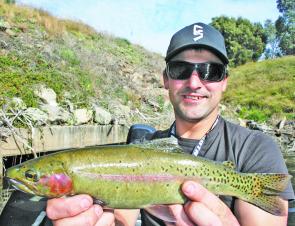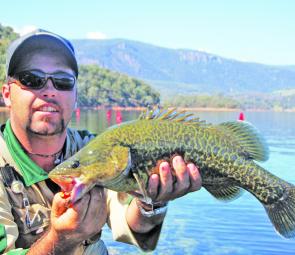Blowering Dam remains picture-perfect at near full capacity. It has been full for as long as anyone can remember and if the regular rain we have had already this year continues then the dam will remain close to full for quite some time.
Anglers are slowly learning to adapt to the new locations and strategies required to land fish regularly. Most of the pine and native trees and shrubs that don’t like to have wet feet have well and truly died and almost all the leaves have now fallen off these lure- and hook-grabbers.
This is not to say that you won’t get snagged but it does mean you will get snagged less often.
Tackle Backs and pole retrievers have been worth their weight in gold and if you don’t already own one I strongly recommend you get one. We would have saved well over $1000 worth of snagged lures this year.
With Winter in full swing, so too are the redfin spawning efforts. This is easily the best time to catch trophy-size redfin.
The majority of fish are still feeding up but are also competing with each other for food and for position beside the biggest females.
Anglers don’t have to find structure, they just need to find a female and there are sure to be 50 or more males in very close proximity.
Almost all lures dropped in front of these fish will get eaten, either out of hunger or aggression as they attempt to try to keep the opposition away – or preferably eat it if possible.
Jigging is easily the best way to take advantage of these schooled redfin but it is possible to reach these deep holding fish from the bank.
If you are bank-bound, fish from any steep points. Bait will do the job but best results will come from repeat casting with soft plastics rigged on jig heads between fro 1/4oz to 5/8oz, spinners, tail spinners, lipless crankbaits or blades.
Those with a boat can find schools with the aid of a good sounder or by trolling small deep-diving lures.
Once a school is located, jigging with ice jigs, soft plastics, blades or lipless crankbaits is the best way to get big numbers. When fishing this way in the right areas it is nothing to catch well over 100 fish in a day.
Don’t forget the new NSW regulation which prohibits the release of redfin. No redfin must be returned to the water and preferably should be used for food, fertiliser, berley or pet food. Otherwise, dispose of them appropriately and they are not to be returned to the water.
The night trollers have come out in droves. It is now common knowledge that big Murray cod are caught more readily in Winter.
It is also starting to become common knowledge that Blowering’s cod are almost all nocturnal, particularly the really big models.
So it makes sense that to maximise chances of a trophy Blowering cod you should focus your efforts in the winter months at night.
Most night stalkers troll with big lures, but not necessarily deep-divers. Any big lure that gets down to about 5m gives you a good chance.
The most trolled depth seems to be about 6m or 7m but don’t be afraid to go much shallower in search of a hunting fish.
Casting is another great way to target these cod, particularly up in the shallows. Use long, probing casts and operate your electric motor as little as possible to minimise spooking wary fish.
Best lures for casting are those you would troll, as well as big lipless crankbaits, spinnerbaits, shaker blades (Chatterbaits, etc) and soft plastics.
Although Blowering doesn’t have the sort of trout numbers of neighbouring Jounama Dam, it does still have a good population and they are worth targeting.
At this time of the year a lightly weighted piece of PowerBait is always a good option but garden worms and wood grubs also work well.
Lure anglers can flatline troll Tassie Devil style lures, lipless crankbaits, small hardbodies or small soft plastics.
Casting these lures around the shallow margins early and late in the day is also a great way of hooking a trout.
Facts
LIFEJACKETS, PLEASE
Blowering Dam comes under the ‘alpine waters’ category in the new NSW lifejacket laws. If your boat is under 4.8m all occupants must at all times wear a lifejacket. To save yourself a fine, and possibly your life, make sure you supply and fit the correct type of lifejacket (PFD1) for all your crew.

Craig Barber caught this Blowering Dam trout on a lipless crankbait. With the streams closed, it’s time to hit the dams for your trout fix.

Small Murray cod, like this one caught from the bank at Blowering Dam’s wall, can be caught all day long through Winter. But if you’re after one of those giant fish you’ll need to rug up and fish after dark for your best chances.

If you’re targeting redfin schools at Blowering Dam this month, this is the sort of thing you want to see on your sounder – a massive school of redfin hanging close to the bottom. Jigs, plastics, blades and lipless crankbaits will catch these fish.




